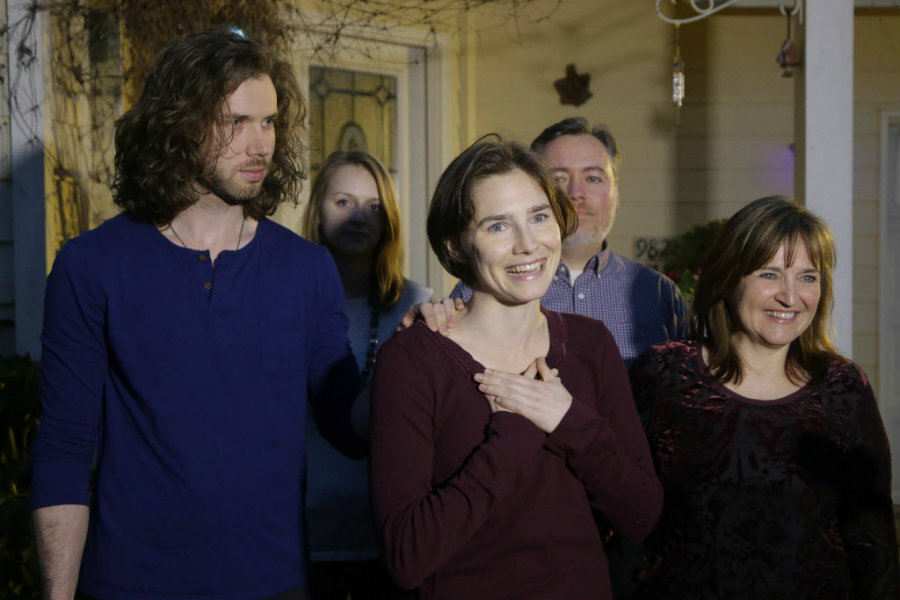Amanda Knox: Why was the murder conviction overturned?
Loading...
Amanda Knox’s legal saga is over.
On Friday, Italy’s highest criminal court acquitted Ms. Knox, an American, and her Italian ex-boyfriend Raffaele Sollecito of murdering British student Meredith Kercher in 2007. Lawyers for Mr. Sollecito had urged the courts to overturn the pair’s 2014 murder convictions, arguing that the guilty verdicts had been made as a result of errors of “colossal proportions,” according to The Associated Press.
The ruling, which follows three earlier, flip-flopping court decisions, is final, and the reasons behind the verdict will be released in writing within 90 days, the BBC reported.
Knox had been sharing an apartment with Ms. Kercher and others at the Italian university town of Perugia in 2007 when Kercher was found in her bedroom with her throat slashed. Knox and Sollecito were convicted in 2009, with Knox given a prison sentence of 26 years and Sollecito 25.
In 2011, an Italian appeals court acquitted the pair, noting that the first trial had produced no murder weapon, no motive, and no DNA results that convincingly tied Knox or Sollecito to the murder, according to the AP.
Having served four years in an Italian jail, Knox went home to Seattle and Sollecito returned to his studies in computer science.
Italian prosecutors later appealed the acquittal and were granted a new trial. In early 2014, a court in Florence upheld the original guilty verdict, this time sentencing Knox in absentia to 28 ½ years in prison. Sollecito’s original conviction was also upheld, and he was given a 25-year sentence.
The latest – and reportedly last – decision was made after judges from Rome’s supreme court heard final arguments in Kercher’s murder Wednesday, during which attorney Giulia Bongiorno said that the Florence appellate court ruling showed errors of fact and logic, reported the Los Angeles Times.
The ruling said that a female footprint had been found in blood in the room where Kercher was killed, whereas it was Guede’s footprint, she said. She added the ruling wrongly claimed no one had entered the room between a first and a second search, when Kercher’s bra-clasp was found, allegedly covered with Sollecito’s DNA. “Thirty-five people entered that room,” she said.
Bongiorno also asked how Knox had not left a DNA trace in the room if she had killed Kercher. “Only dragonflies do not leave a trace,” she said.
She added that Knox’s original statement to police, which would have exonerated her, was never entered as evidence and was later changed, Fox News reported.
The five judges "delivered a definitive acquittal” Friday, according to the BBC. Had they ruled the other way, the decision could have resulted in an extradition request for Knox, who is still living freely in the United States. Sollecito, who lives in Italy, would have gone to jail immediately.
Kercher’s relatives were not present at the hearing, but prosecution lawyer Francesco Maresca told the British network, "I think that it's a defeat for the Italian justice system."
Who, then, killed Kercher?
Rudy Guede, an Ivory Coast native raised in Italy, whose fingerprints and DNA were found at the scene, was convicted in 2008 of sexually assaulting and killing Kercher. He is serving a 16-year prison sentence. But Italian prosecutors had argued that Knox and Sollecito were Guede’s accomplices.
Following her acquittal Friday, Knox made a brief statement from her mother’s home in Seattle, saying she was “relieved and grateful,” CNN reported.
“The knowledge of my innocence has given me strength in the darkest times of this ordeal," according to the statement. "And throughout this ordeal, I have received invaluable support from family, friends and strangers. To them, I say: Thank you from the bottom of my heart. Your kindness has sustained me. I only wish that I could thank each and every one of you in person."
After Knox returned to the US in 2011, she finished her degree in Creative Writing at the University of Washington and has worked as a freelance journalist for the West Seattle Herald. She was paid $4 million for her "steamy" memoir, "Waiting to be Heard," according to the New York Daily News. She's reportedly engaged to a musician, Colin Sutherland.







